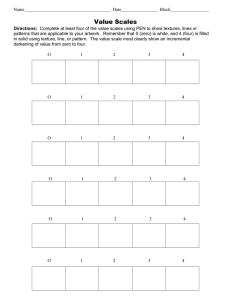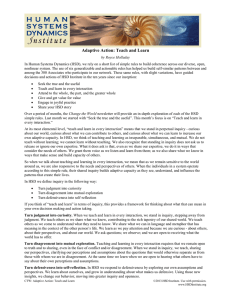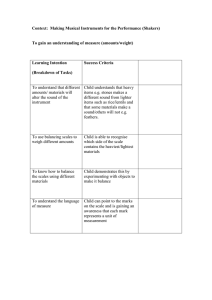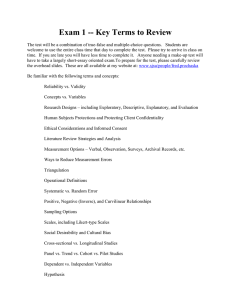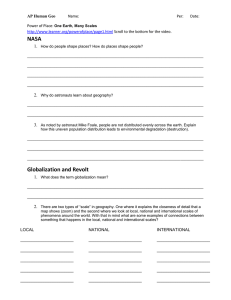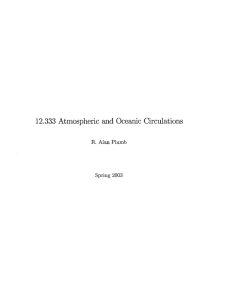Attend to the Whole, the Part, and the Greater Whole
advertisement
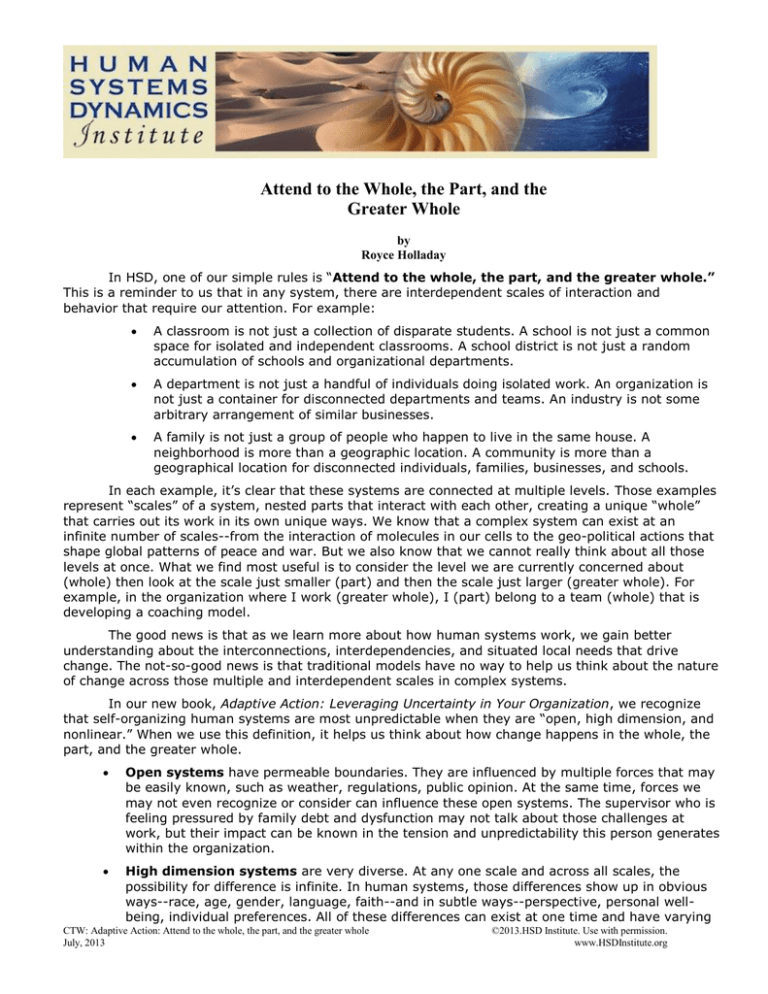
Attend to the Whole, the Part, and the Greater Whole by Royce Holladay In HSD, one of our simple rules is “Attend to the whole, the part, and the greater whole.” This is a reminder to us that in any system, there are interdependent scales of interaction and behavior that require our attention. For example: A classroom is not just a collection of disparate students. A school is not just a common space for isolated and independent classrooms. A school district is not just a random accumulation of schools and organizational departments. A department is not just a handful of individuals doing isolated work. An organization is not just a container for disconnected departments and teams. An industry is not some arbitrary arrangement of similar businesses. A family is not just a group of people who happen to live in the same house. A neighborhood is more than a geographic location. A community is more than a geographical location for disconnected individuals, families, businesses, and schools. In each example, it’s clear that these systems are connected at multiple levels. Those examples represent “scales” of a system, nested parts that interact with each other, creating a unique “whole” that carries out its work in its own unique ways. We know that a complex system can exist at an infinite number of scales--from the interaction of molecules in our cells to the geo-political actions that shape global patterns of peace and war. But we also know that we cannot really think about all those levels at once. What we find most useful is to consider the level we are currently concerned about (whole) then look at the scale just smaller (part) and then the scale just larger (greater whole). For example, in the organization where I work (greater whole), I (part) belong to a team (whole) that is developing a coaching model. The good news is that as we learn more about how human systems work, we gain better understanding about the interconnections, interdependencies, and situated local needs that drive change. The not-so-good news is that traditional models have no way to help us think about the nature of change across those multiple and interdependent scales in complex systems. In our new book, Adaptive Action: Leveraging Uncertainty in Your Organization, we recognize that self-organizing human systems are most unpredictable when they are “open, high dimension, and nonlinear.” When we use this definition, it helps us think about how change happens in the whole, the part, and the greater whole. Open systems have permeable boundaries. They are influenced by multiple forces that may be easily known, such as weather, regulations, public opinion. At the same time, forces we may not even recognize or consider can influence these open systems. The supervisor who is feeling pressured by family debt and dysfunction may not talk about those challenges at work, but their impact can be known in the tension and unpredictability this person generates within the organization. High dimension systems are very diverse. At any one scale and across all scales, the possibility for difference is infinite. In human systems, those differences show up in obvious ways--race, age, gender, language, faith--and in subtle ways--perspective, personal wellbeing, individual preferences. All of these differences can exist at one time and have varying CTW: Adaptive Action: Attend to the whole, the part, and the greater whole July, 2013 ©2013.HSD Institute. Use with permission. www.HSDInstitute.org impact on the functioning at any given level. At the same time, differences in the community can sometimes have a powerful impact on the relationships between and among the individuals of that community. Nonlinear systems are a product of their history. What we learn from yesterday’s experiences and connections influences our thinking and choices today to create the patterns we will live out tomorrow. Our actions emerge from what we know and have learned from our history, as well as the ways we connect with our environment and with others at any given time. Understanding that phenomenon helps us find viable options for action as we move toward a more coherent future. Dwelling on the past and regaling each other with stories of past slights and personal pain are not helpful. Knowing what we can learn from those stories that can inform and shape our actions and connections today is helpful. Complex systems exhibit these characteristics at each individual scale, and what happens at one scale influences and shapes what happens at other scales in the same system. Consider the example that played itself out in one family in Egypt in recent weeks. At a national scale, economic, religious, social, and political forces were playing themselves out in the streets of Egypt’s cities and town (greater whole) in widespread violence and confusion. Groups of individuals (parts) engaged in the turbulence of this conflict, supporting their shared commitment to either changing or maintaining the status quo. These groups of individuals aligned themselves with those larger factions (whole)-government and military--that were battling each other at the national scale. At the individual level, personal freedoms and beliefs influenced a young man (part) to take action to participate. So rather than taking up weapons, he grabbed a video camera and went out to document the violence and turbulence of change in his own neighborhood. He wanted to document the ravages and rampages of this conflict. In his own family (greater whole) he was at odds with other members (parts) who held a different perspective from his. In the battle, as he collected images to tell the story of this multileveled, massively entangled conflict, he was shot and killed. His family is devastated. His friends and colleagues don’t know who to blame. And the deadly conflict continues. Differences, powerful forces, and unresolved history at all scales continue to contribute to the patterns of violent change that hold Egypt in a deadly grip. As we consider shaping the patterns that make up our lives at home, at work, or in the community, understanding these characteristics of complex systems can help us think about change in more useful and productive ways. The tool we offer this month maps out a set of questions that help you consider patterns as they exist. Rather than simply creating a picture of your world, these questions can help you understand and explain the very nature of those patterns you want to change. Ultimately then because you understand them, you can take powerful and informed action to shift those patterns. Here are steps you can take to see, understand, and influence the patterns around you. 1. WHAT? When you see a pattern you want to change (either to make it stronger or weaker), first use the questions in the tool to name that pattern and describe it thoroughly by reflecting on how it is manifest and shaped at all scales of your system. a. Define the diversity that contributes to the pattern. b. Identify and estimate the impact of the multiple forces at work. c. Look at the stories, heroes, and local culture to discern the history that has generated the current pattern. d. Examine those characteristics at each scale of the system. 2. SO WHAT? Then describe the pattern you want to see in your system. a. In your desired world, what differences would be highlighted? b. What forces get amplified in your system and what forces are damped? How does that happen? c. How are individuals and groups able to learn from their stories to take action today that moves them beyond the helplessness of being bound by the past? d. How do these patterns get carried out at each scale of the system? CTW: Adaptive Action: Attend to the whole, the part, and the greater whole July, 2013 2 ©2013.HSD Institute. Use with permission. www.HSDInstitute.org 3. NOW WHAT? Finally, take action, based on where you stand in the system. a. Consider the influence you have in any of the scales--even if it’s only with the person who is next to you. How might you influence the system at any level to be more or less open? How might you increase or decrease the diversity of the system? What might you do to create or disrupt connections? b. Consider the parts of the system you touch in any way. c. Take action to make the changes you can and to influence the actions of others. You may not be the formal leader, and you may not feel that you have great power in your whole system. That’s not the point. The point is that you can, in fact, shift system-wide patterns by shifting those patterns you can touch. When you attend to the whole, the part, and the greater whole, you can see the patterns across the system more clearly, understand their implications and impact more thoroughly, and take informed action to influence the patterns of the future. Using this tool can help you do that. Please be in touch and let us know how things go in your system. CTW: Adaptive Action: Attend to the whole, the part, and the greater whole July, 2013 3 ©2013.HSD Institute. Use with permission. www.HSDInstitute.org Influencing Your System Whole - Part - Greater Whole CTW: Adaptive Action: Attend to the whole, the part, and the greater whole July, 2013 ©2013.HSD Institute. Use with permission. www.HSDInstitute.org

